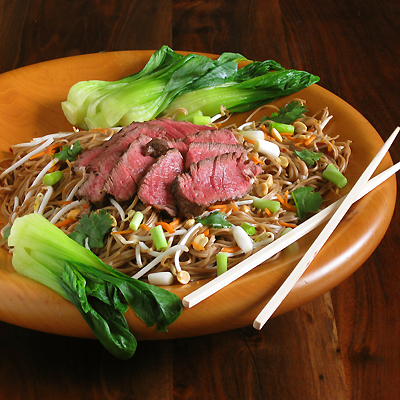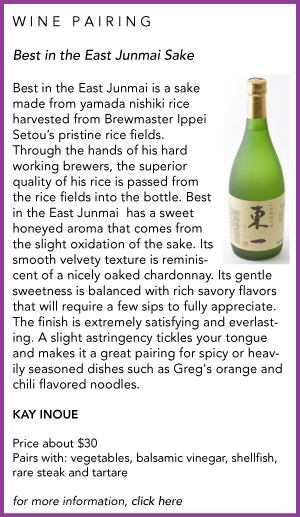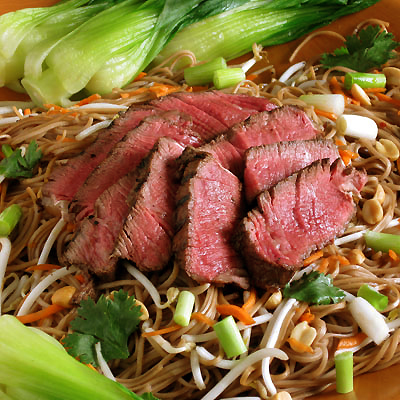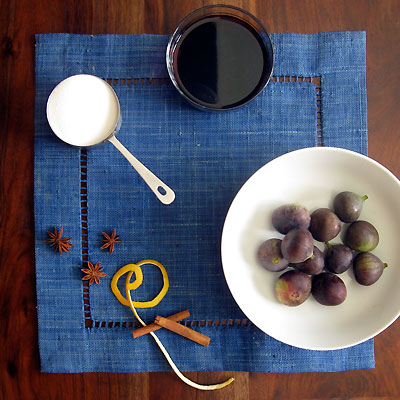
I am going to try and cover a lot of ground today!
Not only do I have a recipe, Cold Orange Chili Oil Noodle Salad with Steak. Which you probably fully anticipated. But what you might not have expected is a guest post and primer on sake.
So let me take a moment and wind my way through all the events that led to noodles and sake landing on Sippity Sup. It all starts with La Fuji Mama. How many sentences begin that way? Rachael is a real life blog instigator, so I need to give a shout out to her. She recently taught a super fun sushi making class at my house. She called it Sushi 101 and you can read all about it HERE. Not only did we learn how to make temakizushi (a traditional hand roll in a cone shape) and maki sushi (sushi rolls), but we had a special guest that evening. His name is Kay Inoue and he is with Banzai Beverage, importers of premium (you guessed it!) sake.
I really enjoyed all the sakes I tasted that evening and Kay had so much interesting information that I just had to ask him to do a guest post.

I am sure you know that sake is wine. You may even know it is rice wine. But there is so much more to fine sake than the warmed over swill that was first introduced to Americans of my parent’s generation. Good sake has many nuances and is a wonderful accompaniment to so many different foods. So not only have I asked Kay to enlighten us on some of sake’s finer points, but I have asked him to do a pairing for my cold noodle salad.
It’s a great recipe for a party because it gets better after sitting several hours, so its easy to make ahead and keep it in the refrigerator until serving time. It’s also perfect when the days are hot. L.A. is having a bit of a late-season heat-wave right now. So these cold noodles and Kay’s impeccable sake choice is a great way to escape the heat.
Take it away Kay!
 What is sake? The top grades of sake fall under a category called special designation sake. By law, ingredients are limited to rice, koji rice (rice saccharified by koji mold) and water. When a sake contains only these three ingredients, it earns the designation of junmai which means “pure rice”. There are over 60 different rice varieties developed specifically for sake making. Rice is gently milled to polish away proteins, fat and vitamins. The idea is to expose the soft starchy core to bring out the pure flavors of the rice. When rice is polished 40% or more, the sake earns the designation of ginjo. The daiginjo designation requires a polishing ratio of at least 50%. (White rice that you eat is only polished away 8%.) Using these keywords, we can determine that a junmai ginjo is a “pure rice” sake with the rice polished away at least 40%. Also, sake with just a junmai designation is not required to have minimum polishing ratios. The general rule is that sake becomes more delicate and lighter bodied as you polish away more rice. After polishing, rice is soaked in water then steamed to lock in the moisture. A naturally occurring mold called koji can now grow on the rice and break down starch into fermentable sugars.
What is sake? The top grades of sake fall under a category called special designation sake. By law, ingredients are limited to rice, koji rice (rice saccharified by koji mold) and water. When a sake contains only these three ingredients, it earns the designation of junmai which means “pure rice”. There are over 60 different rice varieties developed specifically for sake making. Rice is gently milled to polish away proteins, fat and vitamins. The idea is to expose the soft starchy core to bring out the pure flavors of the rice. When rice is polished 40% or more, the sake earns the designation of ginjo. The daiginjo designation requires a polishing ratio of at least 50%. (White rice that you eat is only polished away 8%.) Using these keywords, we can determine that a junmai ginjo is a “pure rice” sake with the rice polished away at least 40%. Also, sake with just a junmai designation is not required to have minimum polishing ratios. The general rule is that sake becomes more delicate and lighter bodied as you polish away more rice. After polishing, rice is soaked in water then steamed to lock in the moisture. A naturally occurring mold called koji can now grow on the rice and break down starch into fermentable sugars.
Unlike grapes, breweries can buy the best rice and have it shipped across the country. However, the spring water used in sake making cannot be transported because it’s unpasteurized. Therefore, breweries are always located on top of a prime water source. Every well will have its own unique water. This is the regional style of sake! Regardless of rice or water, the single most important ingredient is love. This love comes from the brewmasters who have accumulated nine, ten and even fifteen generations of sake making knowledge. The best brewmasters believe in doing everything that is good for the sake. This is why every single grain of rice will be touched by a skilled brewer’s hand and pampered with care until the sake reaches your dinner table.
So what is this hot stuff I get at my sushi joint? Ironically, sake was traditionally never served hot. This piping hot style became popular during World War II when massive rice shortages forced breweries to produce the maximum amount of alcohol with the smallest amount of rice possible. This was done by adding “special ingredients” like grain syrup, glucose, artificial rice flavor and pure industrial ethanol to quadruple the volume of sake produced per kilogram of rice. (There were a few breweries that produced artificial sake with no rice added at all!) Needless to say, this grade of sake did not taste very good. To make it drinkable, binge drinkers heated the sake until the harsh aromas boiled off and the bitterness was softened. It quickly became the cheap drink of choice among the demoralized war time population. The breweries have since taken advantage of the widespread misconception of sake and continued to sell low quality “cooking grade” sake. –Kay Inoue
Cold Orange Chili Oil Noodle Salad with Steak serves 4 CLICK here for a printable recipe
- 2 USDA choice or better filet mignon steaks, about 2 inches thick
- 1⁄2 c plus 2 tablespoons soy sauce, separated
- 1 T peanut oil
- 1 t chili paste
- salt and pepper as needed
- 4 whole baby bokchoy
- 1 lb very thin asian noodles of your choice
- 3 T chili-oil
- 1 T asian fish-sauce
- 1 T granulated sugar
- 1⁄4 c rice vinegar
- 1 T toasted-sesame oil
- zest from 1 orange
- 8 oz fresh mung bean sprouts
- 1⁄2 c coarsely shredded carrots
- 1 bn scallions sliced into 1/2‑inch lengths
- 1 c loosely packed whole cilantro leaves
- 1⁄2 c dry-roasted peanuts
 Mix 1/2 cup soy sauce, peanut oil in a small bowl. Rub both sides of each steak with a bit of chili paste. Add the steaks to the soy mixture and let them marinate about 1 hour, turning occasionally.
Mix 1/2 cup soy sauce, peanut oil in a small bowl. Rub both sides of each steak with a bit of chili paste. Add the steaks to the soy mixture and let them marinate about 1 hour, turning occasionally.
Heat the grill or grill pan to medium-high heat. Remove the steaks from the soy mixture and generously season them. Cook for 3 minutes, rotate the steaks 1/4 turn to make nice crosshatch marks, and then cook another 2 minutes. Flip and cook another 3 to 4 minutes for medium-rare, or to your degree of desired doneness. Remove to a platter and let cool. Once cool they may be refrigerated overnight if needed.
About an hour before serving, bring a large pot of salted water to a boil over high heat. Have a bowl of ice water handy. Drop the baby bok choy into the water and cook about 3 minutes. Use tongs and remove them to the ice bath to stop cooking. Remove them from the bath drain and refrigerate. Retain the boiling water and ice bath for the noodles.
Drop the noodles into the boiling water and cook, stirring often to prevent sticking, until the noodles are al dente. About 2 minutes. Drain and then submerge them in the prepared ice water bath. Once cool drain well and refrigerate 1 hour. Discard boiling water and ice bath.
In a large bowl whisk together chili oil, remaining 2 tablespoons soy sauce, rice vinegar, sesame oil, Asian fish sauce, pinch of salt, sugar, orange zest. Add the bean sprouts, shredded carrots, sliced scallions, cilantro leaves and cold noodles to the bowl. Toss to coat well. Cover the bowl and move it to the refrigerator to completely chill.
When ready to serve, turn the whole bowl and its liquid onto a serving platter. Toss the peanuts over the noodles and top with the reserved steak slices; place the baby bok choy alongside. Serve cold.

I found your recipe on another blog site and followed the link to your blog. Great site. I am into Japanese food and would like to try a few more Japanese-inspired sashimi recipe. My most recent creation is Salmon Sashimi with Blue Cheese and White Miso Puree http://cuceesprouts.com/2010/10/ simple to die for. Check it out if you are interested